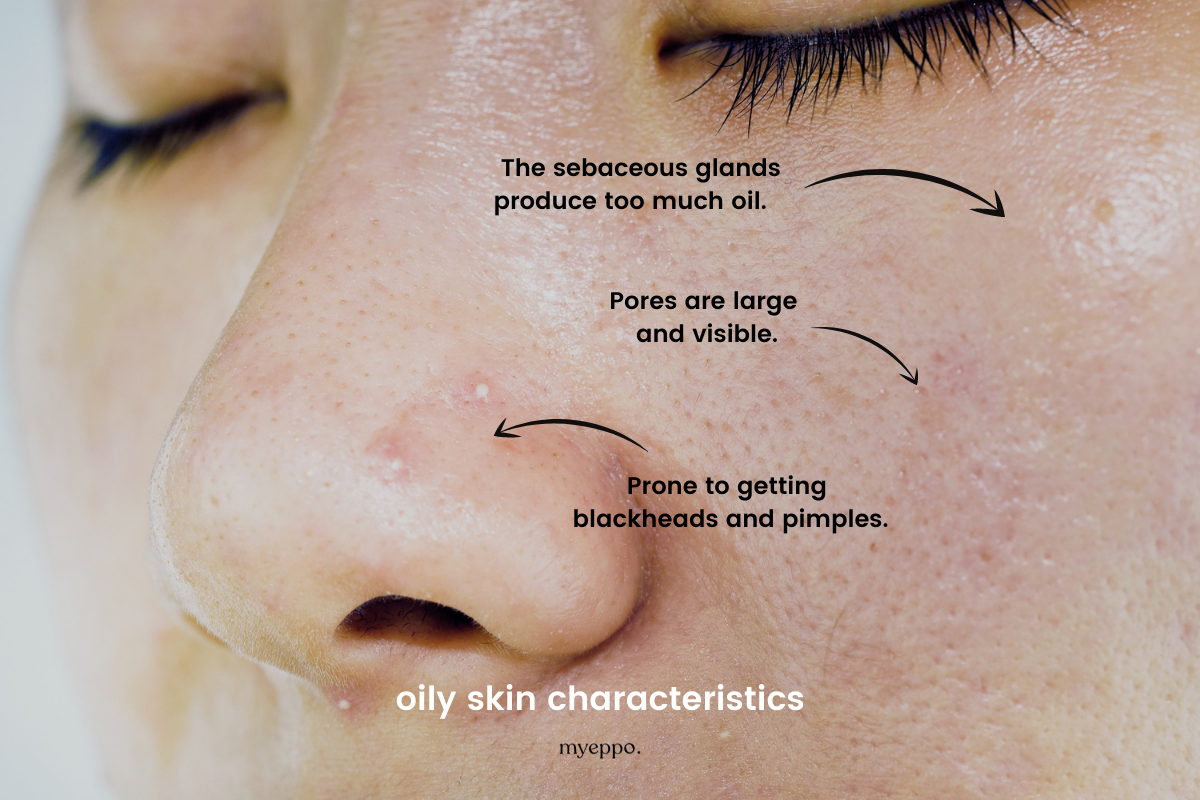No products in the cart.
- January 3, 2022
- Oily
- By Aqalili Azizan
Getting To Know My Skin: Oily Skin 101
There are tons of oily skin characteristics, but there's also a way to reduce the shine.
Table of Contents

“Wow, your face is so shiny I need sunglasses just to look at you!”
Can relate?
Well condolences my friend, but you probably have oily skin. Blotting papers and mineral powder are a monthly purchase.
“Why do they make blotting paper so small?!”
“Is there a jumbo size facial powder?”
These are just a few burning questions of an oily-skinned person.
Need to know more? Read on.
What is Oily Skin?
Under each pore in your face lies a gland called the sebaceous gland. As part of its normal function, it naturally produces an oil called sebum. Sebum is meant to maintain the natural moisture of your skin and protect your skin from moisture loss.
Unfortunately for some people, the sebaceous glands produce too much oil, creating oily skin.
The extra sebum production leads to clogged and enlarged pores which can lead to breakouts and acne, on top of looking like an oil slick.
But don’t you worry, there’s a way to treat it by knowing more about oily skin types. The best solution is to learn and get to know your skin. It’s just like you found a recipe to cook for dinner!
How Can I Identify Oily Skin?
You can learn how to determine your skin type in our previous article here, and trust me, the process is straightforward! If you tick all of this checklist after washing your face and wait for one hour, your skin type is oily.
✅ Your face feels very slick and shiny all over, especially at the end of the day.
✅ You still feel unclean or start to feel greasy very shortly after washing your face.
✅ Pores are large and visible.
✅ Prone to getting blackheads and pimples.

Why Do I Have Oily Skin?
Oily skin can be caused by several factors, including genetics, location, season and lifestyle factors that affect the sebaceous glands.
- Genetics:
Overactive sebaceous glands can run in families, and is passed down from parent to child via their genes.
- Weather:
Weather plays a big factor in the appearance of oily skin. Tropical climates have high heat and high humidity, which stimulates the sebaceous glands to produce more sebum than usual.
In addition, this high heat climate causes us to sweat more. Sweat (water) and oil don’t mix, causing two reactions. One, sweat has a harder time evaporating as it is sitting under a layer of sebum. Two, the oil that sits on top of the sweaty skin makes the shine look worse than it actually is.
- Poor Diet:
Diets rich in sugar and simple carbohydrates have been shown to increase growth hormone levels, leading to increased sebum production. Studies have shown a link between low-glycemic diets and a reduction in sebum production and vice-versa.
- Stress:
When you’re stressed out, your body releases a flood of stress hormones, known as corticotropin-releasing hormones. These hormones can attach themselves to the skin’s sebaceous glands causing them to increase oil production.
- Hormones:
Testosterone, the male hormone (also present in females although at a much lower level) can affect sebaceous glands. Studies have suggested that higher levels of testosterone lead to an increase in oil production. This is why it’s common for teenagers to experience oily skin around puberty when hormones are at their peak levels.
Interestingly, the female hormone estrogen is associated with lower levels of oil production. This has been suggested as a reason that oily skin is more prominent amongst men.
- Over-washing your face:
Even though it’s tempting to wash your face regularly to provide relief against the oil, the last thing you want to do is wash your face or exfoliate too often. Overwashing strips away too much oil from your skin. This makes your sebaceous glands produce even more oil to compensate, totally defeating the purpose.
- Using the wrong skin care products:
Some people mistaken combination skin for oily skin, and they might use heavier moisturisers that can make the skin oilier and clog skin pores. Additionally, many people with oily skin feel the need to use strong, harsh products and acids, which completely strip the skin totally of all its natural moisture and hydration. The result? The skin overcompensates by producing even more oil. A vicious cycle!
How Do I Take Care of Oily Skin?
There isn’t a 100% solution to get rid of the problem, especially when the overproduction of sebum is caused by genetics or the weather (unless you move to a country with a different climate, but that seems like a pretty drastic step).
However, we can train the skin to control the overproduction of oil with a solid skincare routine for oily skin.
The key to skincare for oily skin is to build a routine that is balanced – gentle, yet hydrating.
Here’s why — we need the skin’s natural oils to keep our skin soft and maintain our natural skin barrier that keeps moisture in and environmental irritants out. So we don’t want to completely remove every ounce of oil. At the same time, we want to increase hydration and moisture to the skin, as a signal to our body that our skin is sufficiently hydrated, and doesn’t need so much oil to be produced.
It’s very tempting to use products that give you that “squeaky clean” feeling, but this only makes things worse as they tend to strip the skin completely of all its natural moisture. This causes the sebaceous glands to produce even more oil to compensate, and we don’t want that!
Step 1: Cleanse daily and exfoliate
Keep your skin clean, and your skin will thank you. Cleansing removes dirt and grime that can combine with the excess oil on your skin, leading to acne and breakouts. For oily skin, a gentle, hydrating cleanser is always recommended.
To get soft and smooth skin, try exfoliating products containing salicylic acid or glycolic acid to reduce excess oil production. Exfoliants also break up and dissolve the oils that are clogging pores, reducing the frequency and likelihood of breakouts.
Step 2: Always use moisturiser
If you’re ditching your moisturiser, that’s a common myth for oily skin. People often mistake skin oil for skin hydration. Even if you have active sebum glands, your skin can still be dehydrated! This causes your skin to overproduce oil as a way of adjusting, making you look more oily than usual. So hello, shiny forehead!
Always keep your skin well-moisturised. Look out for ingredients such as glycerin, hyaluronic acid or niacinamide to help hydrate and even out your skin tone if you’re healing from acne or environmental exposure that leave dark marks. Zinc is also a great ingredient that can reduce sebum production. Look out for products with “non-comedogenic” on the label, so it won’t clog pores.
Step 3: Don’t skip sunscreen!
Finding a sunscreen that can suit oily skin can be hard. So, people with oily skin tend to skip using it because it can make their skin feel oilier and “heavy”. No matter what your skin type, sunscreen is important to avoid you from getting sunspots, or worse, skin cancer.
Oily skinned folk should opt for chemical sunscreens which are usually thin and spreads easily onto the skin, without that heavy, turgid texture. Look out for chemical sunscreens that are hypoallergenic and are free from oil, fragrance and parabens.
There you have it, when you find the right sunscreen for your oily skin, your skin is protected from harsh UVA and UVB.

Play Safe with These Ingredients
Remember the key to an oily skin routine is balance — keeping skin hydrated without stripping the skin of all its natural moisture.
It’s best to keep it simple and not overdo putting skincare products on your skin. Look out for these ingredients that work great with your oily skin!
- Kaolin: The absorbent ingredient targets excess oil, blackheads, and shine, resulting in softer, smoother and more mattified skin.
- Bentonite clay: The clay can help remove sebum or oil from the skin’s surface, and it may also have a calming effect on inflamed breakouts.
- Salicylic acid: This acid is lipophilic, meaning it likes oil. So, it gets into the pore and sucks the oil out.
- Glycolic acid: A powerhouse ingredient that can help reduce excessive oil and plugging of pores that leads to acne breakouts.
- Hyaluronic acid: A lightweight ingredient that draws moisture from the environment and is intensely hydrating.
- Niacinamide: A Vitamin C3 that strengthens the skin barrier and increases its renewal rate to help the appearance of hyperpigmentation and large pores.
- Zinc: An effective ingredient that works to reduce sebum production by the skin.
There you have it! You can consider these six best skincare ingredients for oily skin when purchasing new products. Most importantly, don’t feel stressed out and make sure to enjoy the process of finding the right one for your skin!
Are you still confused about your skin type? Try the myeppo skin quiz for free! After five minutes with 14 questions, you can start to explore a skincare routine that suits your skin type.

